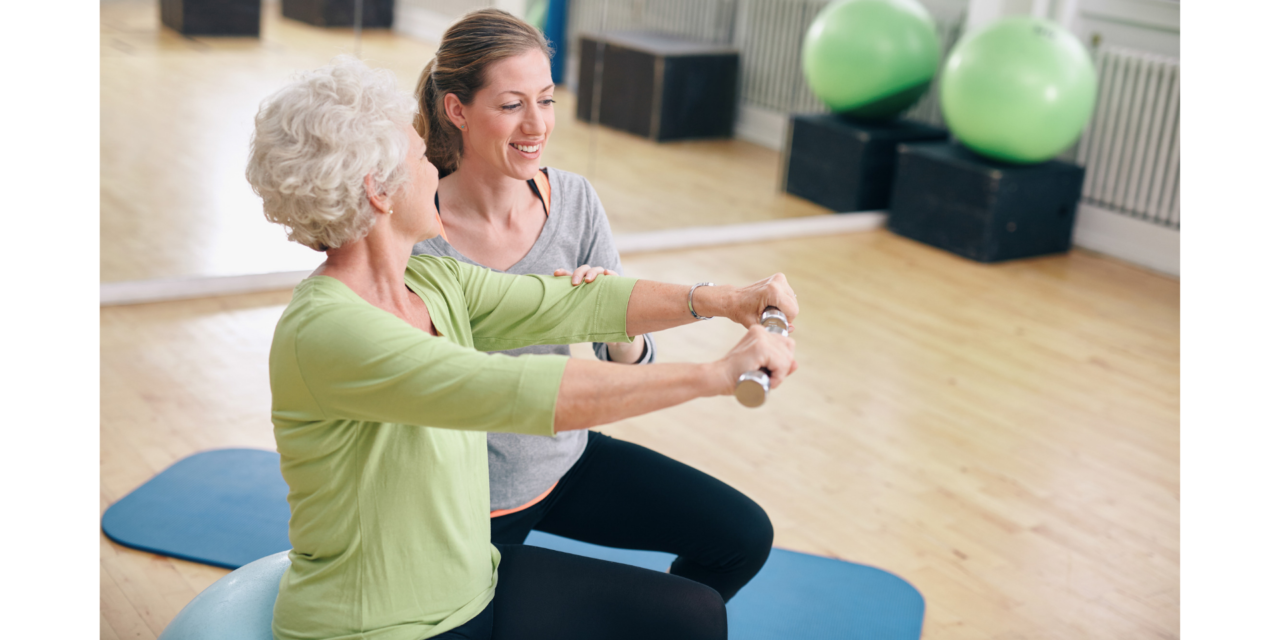Functional Fitness. You may have heard the term, but what exactly is it, and how can it help you in everyday life?
Functional fitness describes the level of muscular strength, cardiovascular endurance, balance, and flexibility necessary to perform activities of everyday living safely and effectively.
Let’s take a look at some common activities you would likely perform in a day and see how a low level of functional fitness might negatively affect you.
Let’s start with getting out of bed. Is it difficult to move to the edge of the bed, push yourself up from lying down to a seated position, or stand up when getting out of bed? What about getting up and down from the toilet (let’s face it, we all know this can be challenging!) or standing up from a low chair, especially if there are no arm rests to push on?
Have you ever found it difficult to carry bags of groceries into the house? What about lifting a suitcase into and out of the trunk of your car? Are you able to squat down to pick up something from the floor or bend down to hug your grandkids? How do you feel about climbing a flight of stairs?
Have you felt like your level of athletic performance has declined when participating in hobbies or sports such as tennis, golf, hiking, or biking? Felt tired, weak, or winded when walking in a store or across a parking lot?
If you can relate to any of these situations, you’re not alone. In fact, that’s why the concept of functional fitness has become so popular among people of all ages and ability levels. Whether you are active and want to improve your ability to perform in sports or hobbies, or you are more sedentary and find yourself having trouble maintaining your independence with daily activities, functional fitness is for you.
Now that you have a better understanding of what functional fitness is and how important it is in helping us stay strong, mobile, and independent, I’m going to show you seven functional fitness exercises to get you moving in the right direction.
As a physical therapist, I use these exercises with my clients daily and have seen remarkable improvements in strength, balance, and confidence. I recommend performing each exercise two to three times per week. Start with five to ten repetitions of each exercise at a time, with good form. Slowly work your way up to the suggested number of repetitions for each exercise as you are able. Muscle soreness is not a bad thing, but stop an exercise if it causes you pain.
1a. Squats
Squats strengthen the lower body muscles that are essential for being able to get up from a couch, chair, or the toilet. If you get down on the floor to do exercises, play with the grandkids, or if you fall, you will need sufficient leg strength to help you get back up on your own.
- Begin by standing in front of a sturdy chair with your feet at least shoulder-width apart.
- Bend your knees and bend forward at the waist, and slowly lower yourself down to a seated position in the chair.
- Push through the heels and squeeze the buttocks as you return to standing. Perform 1 to 3 sets of 10 reps.
1b. Air Squats
Want to increase the difficulty of this exercise? Try an Air Squat! The Air Squat involves the same motion as the squat, but without actually sitting down on the chair.
- Begin by standing in front of a sturdy chair with your feet at least shoulder-width apart, and your arms held straight out in front of you.
- Slowly bend your knees and bend forward at the waist, as if you are going to sit on the edge of the chair, but do not sit.
- Push through the heels and squeeze the buttocks as you return to standing. Perform 1 to 3 sets of 10 reps.
2a. Multi-directional lunge
When performing daily tasks and activities, we rarely move in straight lines. We move in diagonal patterns that require strength and balance from multiple muscle groups. Think about the way you would move when sweeping or vacuuming, raking leaves in the yard, playing tennis or golf, or even stepping to the side to avoid running into someone while walking in a crowded area. This is where the multi-directional lunge comes in.
- Begin by standing on a firm surface with feet shoulder-width apart. Hold onto the back of a chair or a countertop for safety, if needed.
- Step forward with one foot, slowly bend both knees and lower your body weight a short distance toward the ground.
- Return to the starting position.
- Step backward with one foot, slowly bend both knees and lower your body weight a short distance toward the ground.
- Return to the starting position.
- Step out to the side with one foot, and perform a short squatting motion with both legs.
- Return to the starting position. Forward, backward, and sideways count as one complete lunge. Perform 1 to 3 sets of 5 three-way lunges on each leg.
2b. Modified Multi-Directional Lunge
If the multi-directional lunge exercise is too difficult or causes knee pain, try this modified version:
- Begin by standing on a firm surface with feet shoulder-width apart. Hold onto the back of a chair or a countertop for safety, if needed.
- Slowly bend one knee slightly, then reach forward with the opposite leg, tapping the toes to the ground.
- Return to the starting position.
- Bend knee and reach with opposite leg, tapping toes to the ground out to the side.
- Return to the starting position.
- Bend knee and reach with opposite leg, tapping toes to the ground behind you.
- Return to the starting position.
3. Step-ups
This exercise is all about helping you climb stairs and safely conquer curbs. It targets the quadriceps and gluteal muscles in your legs to build strength.
- Begin by standing in front of a bottom stair, facing the stairway. Make sure you have a rail to hold onto for safety.
- Place one foot on the bottom stair.
- Without pulling on the railing, step up onto the bottom stair. Be careful not to “hop” onto the stair, but rather use the leg muscles to perform a controlled step-up motion.
- Slowly step back down to the starting point. Perform 1 to 3 sets of 10 reps on each leg.
4. Wall push-ups
The wall push up is a modification of the traditional floor push up. It is easier on the shoulders and easier to do, but can be just as effective at helping you get stronger. It strengthens the arms, chest, and upper back to prepare you for such tasks as pushing a heavy door open, using your arms to help you push when standing up from a chair, and to help bring yourself to a position where you can get up from the floor if you fall.
- Begin by standing 2-3 feet in front of a wall. (The further away from the wall you stand, the harder the exercise will be.)
- Place your hands at chest-height on the wall in front of you with arms outstretched, about shoulder-width apart.
- Slowly bend your elbows and lower your chest toward the wall.
- Push with your arms to return to the starting position. Perform 1 to 3 sets of 10 reps.
5. Bridges
Bridges are perfect for strengthening the gluteal muscles, lower back, and core muscles. They are the most helpful exercise for moving around when lying in bed, and help you move to the side of the bed in preparation to get up.
- Begin by lying on your back in bed or on a yoga mat on the floor with your knees bent.
- Tighten your abdominal (core) muscles and squeeze your buttocks.
- Raise your buttocks off of the bed / floor, as if creating a “bridge” with your body.
- Slowly lower back down to the starting position. Perform 1 to 3 sets of 10 reps.
6a. Forward-Bent Rows
Rows help strengthen the muscles of the arms, upper back, and around the shoulder blades to help you open doors, pick up a basket of laundry, lift a bag of groceries from the floor, pull a cord to start a lawnmower, and perform a variety of other tasks using the arms.
- Begin by holding a light to moderately heavy dumbbell in one hand. (No dumbbells? Use soup cans or water bottles.)
- Lean forward onto the back of a chair or a countertop, supporting yourself with your opposite arm.
- Squeeze your shoulder blade back and pull the dumbbell up until your elbow is parallel with your body.
- Slowly lower the dumbbell back down. Perform 1 to 3 sets of 10 reps with each arm.
6b. Resistance Band Rows
Alternately, this exercise can be performed in a upright standing position with resistance bands.
- Begin by standing upright, holding resistance band handles, and stepping backward until light tension is felt on the band.
- Slowly squeeze your shoulder blades together, bend your elbows, and pull back on the resistance band until your elbows are parallel with your body.
- Slowly straighten your arms and return to the starting position. Perform 1 to 3 sets of 10 reps.
7. Farmer’s Carry
The farmer’s carry exercise works several muscle groups together to strengthen your core muscles, arms, and legs, as well as helping to improve posture and endurance. Performing this exercise can help you feel stronger and more capable with just about any daily task.
- Begin by standing up straight, holding a light to moderately heavy dumbbell in each hand. (No dumbbells? Use soup cans, water bottles, or fill small canvas tote bags with cans and carry them by the handles.)
- Keep your shoulders relaxed, and gently tighten your abdominal (core) muscles.
- Slowly walk forward, paying attention to your posture and balance. Walk for 30 seconds to one minute, rest, and repeat up to five times.
Remember, as with any fitness program, consistency is key. As a mentor of mine used to say, “These exercises will work, but only if you do!”
Don’t be discouraged if you find these exercises challenging at first, or if you are only able to complete a few repetitions at a time. Start where you can, and with consistent practice, the exercises will become easier as you get stronger.
I think you’ll be pleasantly surprised at the ways you begin to see your daily functional activities get a little easier.
Disclaimer: Always consult your physician before beginning any exercise program. This general information is not intended to diagnose any medical condition or to replace your healthcare professional. If you experience any pain or difficulty with these exercises, stop and consult your healthcare provider.
Sign up below to receive more information, ideas and inspiration about retirement, sent to your email box, free of charge.








